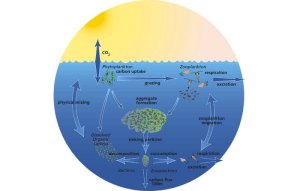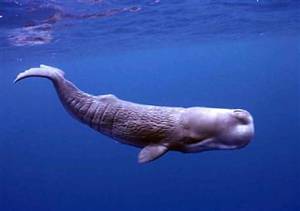Okay, so just a warning, the first half of this post is a mini-lesson on carbon in the ocean for those over achievers who just need to know. To get to the Sperm whale nitty gritty, jump to the section after the asterisks.
******************************************************************
So the name of the game with this climate change thing is carbon – the movement and interchange of carbon in and out of major reservoirs.
This ocean is massively important in the storage of this life sustaining element, and serves mostly as a sink for carbon (in terms of carbon, sinks are where it goes, and sources, where it comes from). It can hold roughly 50 times the amount normally held in the atmosphere.
There is however is robust carbon interplay between the ocean and the living things in it. All the living “stuff” in the ocean can be both sources of carbon (Respirers, like the creepy heavy breather on the other side of the phone line…) or can help move it along into deeper ocean depths where it tends to stay for an extended vacay. The movement of carbon to the ocean bottom is called the biological pump (note, I describe this in simplified terms. Carbon can take little forays off of this cycle – to see what a full cycle looks like, search for biological pump in google images).

Generally, plankton (oh yes, I know there is a definite possibility you are now picturing an ugly, one-eyed bad guy from the enthralling world of sponge-bob, but these are actually real, not just animated-real), the minuscule plants and animals in the ocean, drive the pump. Copepods, tiny planktonic crustaceans, release feacal pellets (read: poop) after eating that hopefully sink to the bottom. Also carbon can help increase plankton populations, and when plankton die (I wish I could insert a clip of taps that played right when you read this…), they sometimes sink to the bottom as detritus, moving alot of the carbon that was just hanging out in the surface down to the sea floor. Carbon in deep waters has a residence time of approximately 1000 years. For it to stay longer, it needs to actually be sequestered (fancy word for “buried”) in sediments, which happens to less than 1% of the carbon entering surface waters. (Note: it’s been suggested injecting carbon into the deep sea or sediments can solve our human carbon-emissions problem, but it comes at a price. See my post on ocean acidification, or my upcoming article on the subject that will be in the spring issue of the online Gulf of Maine Times.)
So, now you know…
And knowing is half the battle….
******************************************************************

According to this article – Sperm Whales as Carbon Sinks -, there were rumors going around that Sperm Whales were respiring out a large amount of carbon being introduced into the Southern Ocean. So they were essentially playing the role of carbon source rather than sink while oblivously swimming around and doing that whale thing they do. But as often happens, we’ve allegedly gotten better at the math, and now it appears they may be more helpful than deleterious in keeping the carbon where it’s supposed to be. When they dive into colder,more nutrient-rich waters to eat squid (See my blog entry on squid, it’s rockin) they bring some of the nutrients back with them which stimulates plankton growth. When the plankton die and sink (or release feacal pellets that sink), they’re setting the balance right and bringing carbon way down deep.
And the best part is these mammoth creatures glide about in their day to day lives, blissfully ignorant of their role in life, the universe, and everything.
Why thank you, that was useful – mostly for the background. I try to understand how the bio carbon pump works/is purported to work, so I appreciate all the info I can get. Like yours above!
I’ve haven’t found too many websites that describe the process in simplified terms. Really the key piece is that these biological processes help move some of the carbon down deep. Carbon that stays in surface waters will just get recycled and may out-gassed back into the atmosphere. There are also chemical and physical processes (collectively called the solubility pump) that help carbon move deeper as well. However, the residence time for carbon in the deep ocean is not forever (roughly 1000 yrs) and those molecules will see other reservoirs again. Less than 1% will be sequestered in sediments for a significantly longer residence time. I’m also writing an article on ocean acidification (deeply related to the carbon issue) that will be in the spring online issue of the Gulf of Maine Times that talks more about Carbon and the oceans!
Thank you for the article. But it does seem quite ludicrous to be describing a “carbon problem” as if a particular species of whale could be a problem. The idea of a carbon cycle in such precarious balance that man’s activities could throw it our of wack, while a favorite shiboleth of Al Gore and his cronies, seems to be in direct contradiction to millions of years of evolutionary history and planetary stability. Of the two options, warming would be a blessing as it would increase plant productivity and spur growth cycles, just as warming periods have done throughout human history.
I agree in some respects it seems silly to describe a species of whale to be that influential in the whole carbon thing. I do think the rate of release of carbon from some reservoirs into others, due to specific human-based activities has far surpassed the mimicking of any natural rate and thus the concern. I think perhaps in past times, humans probably had very little ability to over-power these massively large-scale natural cycles, but it is shocking how much impact we’ve made both on the level of population (there are scads of us, almost in every livable corner of the world, and we are more impacting to our surroundings than bacteria and insects, and other organisms that are just as numerous) and once we became industrial. But I’ll be the first to tell you there are a lot of unknowns in the equation. We are not so great at the whole modeling piece so I can be just as doubtful as the next person concerning climate projections. And sure, warming can kick start some growth have some positives, but all living things are adapted to a very specific range of living conditions – ph, salinity, temperature, etc. – so I think perhaps the synergy of all these pieces is not so straightforward. Too much warming could be detrimental as well. (I will note however, carbon release in the atmosphere and in exchange with the sea also causes cooling as well, the reason why I favor the term “climate change” over global warming) Also, you would expect to see very different ecosystem dynamics, and the balance of species changing quite dramatically (i.e. the idea of reverting back to a “primordial ocean”) that while nature is able to adjust to in some capacity, we might not be so lucky. Even though we often feel far removed from nature and its resources we utilize, a drastic change could put us in dire straits
That is a quite reasonable response. Ultimately, I fall back on evidence. While I am always open to evidence in support of AGW, the more we examine the evidence upon which current claims have been based, the more we find the evidence to be flawed, tampered with, or non-existent.
http://hotair.com/archives/2010/03/31/nasa-climate-data-worse-than-east-anglia-cru/